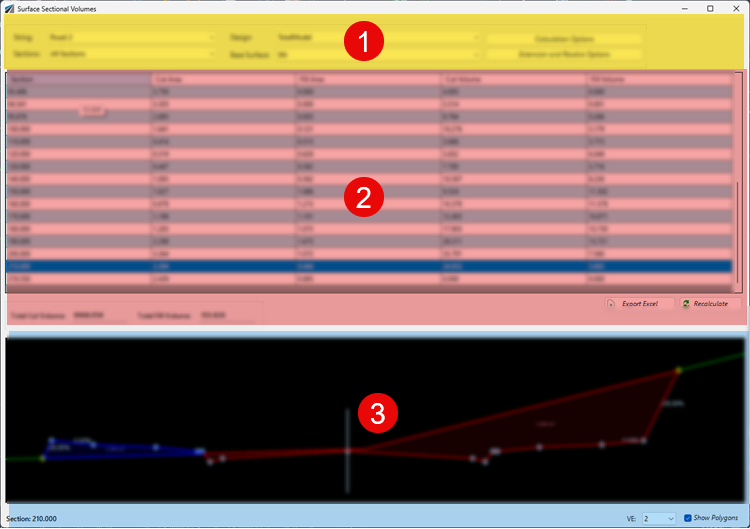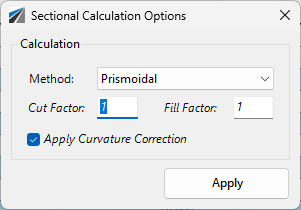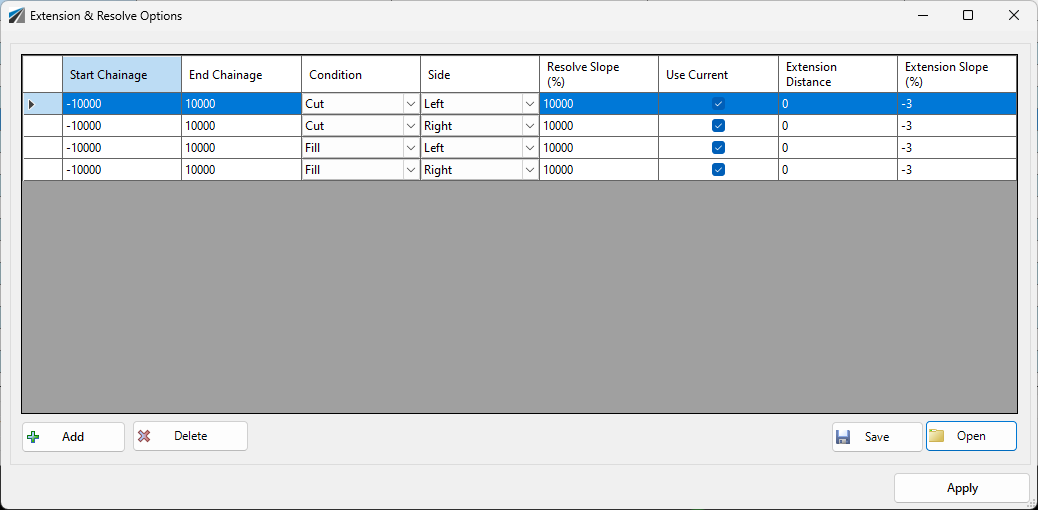Surface Section Volumes
Icon: |
Introduction
This command allows the user to calculate sectional volumes (average end area or prismoidal) from any String. The user can adopt the section sampling of the string or pick a Named Section List for the calculation of cross section frequencies.
The volume calculation is based on the creation of polygonal areas and the user can determine how volumes are managed at the mutual extents of the two surfaces. This command is useful for calculating cross section based volumes for any two surfaces.
Where the two surfaces do not share the same elevation at the mutual extents of the surfaces, and in the absence of any Extension & Resolve controls, the software creates a closed area by drawing a vertical line to match the surfaces at the extents.
Interface
The Section Volumes form is divided into three core parts:

-
Top panel
-
Select the String and sections
-
Select the comparison surfaces
-
Control how volumes are calculated
-
-
Mid panel
-
This includes a number of columes describing the the areas and volume calculations for cut and fill.
-
Pick any section to display in the lower panel
-
-
Lower panel
-
Provides a graphical display of the selected string cross section including the cut/fill area, design codes
-
The user can elect to show cut and fill areas as well as the design calculation lines used for generating the cut/fill areas.
-
The user is able to review any chaiange location and visually see the areas of cut and filll used to calculate volumes.
Cut and Fill Representation - Sections Tab
Cells describing a cumulative cut area/volume will be displayed with a pink background.
Cells describing a cumulative fill area/volume will be displayed with a green background.
Graphical Display
Graphically, cut ares can be shown with red outline and semi-transparent red infill, while fill areas can be shown with a blue outline and semi-tranparent blue infill. The design codes will be displayed with coloured circles.
cut and fill areas will be labelled. Extension and resolve slopes will also be labelled.

Calculation Methods - Average End Area or Prismoidal Method
Two section based volume calculations are supported:
-
Average End Area: obtain the areas of cut and fill for a section and the next section. Average the areas and multiply by the distance between. If curve correction is ticked on, the centroids of the areas left and right of the centreline will be used to calculate the distance between sections.
-
Prismoidal method: calculate a mid area and apply the prismoidal formula
Details
Upon selecting the command the following form is displayed:
|
|
|||||||||||||||
|
String |
Select the string to obtain volumes for | ||||||||||||||
|
Sections |
Select the section spacing. All Sections selection will use all sampled sections for the string. A Named Sections List can be selected to calculate section volumes. | ||||||||||||||
|
Design |
Select the Design Surface | ||||||||||||||
| Base Surface | Select the Base Surface for comparison | ||||||||||||||
| Calculation Options |
|
||||||||||||||
|
Extension and Resolve Options |
|
||||||||||||||
|
Total Cut Volume |
Displays total cut for the selected string |
||||||||||||||
|
Total Fill Volume |
Displays total fill for the selected string | ||||||||||||||
| Excel Export | Generates an Excel (.xls) file and opend for review | ||||||||||||||
| Recalculate | Recalculate the string sections, in case they have been changed while this form was open | ||||||||||||||
|
[Graphic Display] |
Displays the sections and cut/fill areas. |
||||||||||||||
|
VE |
Picklist to set the vertical exaggeration | ||||||||||||||
| Show Polygons | Tick on to show the cut/fill polygon areas. | ||||||||||||||


